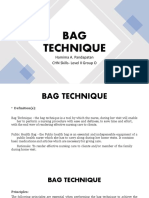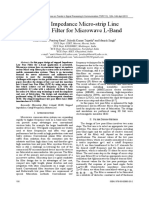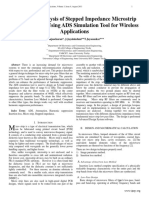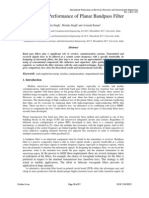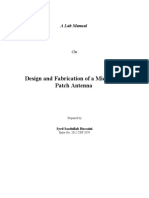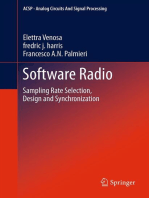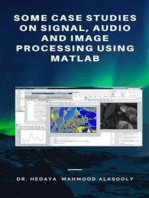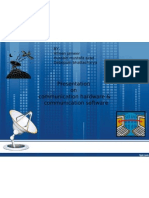Article 5 Jers Vol II Issue II April - June 2011 - 2
Article 5 Jers Vol II Issue II April - June 2011 - 2
Uploaded by
Fa Mido ChemseddineCopyright:
Available Formats
Article 5 Jers Vol II Issue II April - June 2011 - 2
Article 5 Jers Vol II Issue II April - June 2011 - 2
Uploaded by
Fa Mido ChemseddineOriginal Description:
Original Title
Copyright
Available Formats
Share this document
Did you find this document useful?
Is this content inappropriate?
Copyright:
Available Formats
Article 5 Jers Vol II Issue II April - June 2011 - 2
Article 5 Jers Vol II Issue II April - June 2011 - 2
Uploaded by
Fa Mido ChemseddineCopyright:
Available Formats
Journal of Engineering Research and Studies E-ISSN 0976-7916
Research Article
LOW PASS FILTER FOR L-BAND APPLICATION USING STEPPED-
IMPEDANCE MICROSTRIP LINES
Navita Singh, Dr.Avinash Kumar and Pravesh Singh
Address for Correspondence
Department of Electronics & Communication, Krishna Institute of Engineering & Technology, Ghaziabad, INDIA.
E-mail: singh.navita@ rediffmail.com
ABSTRACT
There is an increasing demand for newer microwave and millimeter-wave systems to meet the emerging telecommunication challenges with
respect to size, performance and cost. This paper presents a low cost and low insertion loss L-band lowpass filter (LPF) based on high-resistivity
silicon substrate.Microstrip technology is used for simplicity and ease of fabrication. The design and simulation are performed using 3D full
wave electromagnetic simulator IE3D. The simulated filter achieved an insertion loss of less than 1.0dB in the passband. The filter has a center
fiequency of 1.5GHz with covering the frequency range from 0.5 GHz to 1.55 GHz.
KEYWORDS Low pass Filter, Dielectric Constant, Microstrip filter, Millimeter wave filter
I. INTRODUCTION for simplicity and ease of fabrication.The design and
Microwave communication systems are expanding rapidly simulation are performed using 3D full wave electromagnetic
to higher frequency such as L-band since they can provide simulator IE3D. This filter is widely used today in
many advantages over conventional wireless links, for radar,satellite and terrestrial communication applications.
example the larger bandwidth and smaller device size. II. DESIGN AND ANALYSIS OF MICROSTRIP
Waveguide components are widely used at these frequencies FILTER
and offer very good performance but the result in high The design of low pass filters involves two main steps. The
production costs and bulky systems. Conventional planar first one is to select an appropriate low pass prototype. The
filter structures suffer from radiation from the resonators into choice of the type of response, including Pass band ripple
the substrate and from high ohmic loss, and therefore give and the number of reactive elements will depend on the
high insertion loss and poor filter rejection However, there is required specifications. The element values of the low pass
still a challenge in lowering the cost of the commercial RF prototype filters, which are usually normalized to make a
micromachined device since the devices are fabricated in source impedance go = 1 and a cutoff frequency Ωc = 1.0,
semiconductor- like process. The filters are one of the are then transformed to the L-C elements for the desired
primary and necessary components of a microwave cutoff frequency and the desired source impedance, which is
system.Microstrip line is a good candidate for filter design normally 50 ohms for microstrip filters. The next main step
due to its advantages of low cost, copact size, light weight, in the design of microstrip low pass filters [1] is to find an
planar structure and easy integration with other components appropriate micro strip realization that approximates the
on a single circuit board. Conventional filter structures like lumped element filter. The element values for the low pass
equal ripple and butterworth low pass filters are requirement prototype with Chebyshev response at pass band ripple
of special fabrication methods. Conventional low frequency factor LAR = 0.1 dB, characteristic impedance source/load
techniques for fabrication does not fit at these frequencies Zo = 50 ohms, are taken from normalized values gi i.e. g1,
due to the very high losses associated. Although microstrip is g2, g3, g4......, gn. The filter is assumed to be fabricated on a
not the highest performance filter technology, still it is the substrate of dielectric constant εr and of thickness h mm. for
preferred choice in many thin-film on ceramic and printed Angular (normalized) cutoff frequency Ωc, using the
circuit board applications. RF pre-selector filters, image element transformation [1].
rejection filters, local oscillator (LO) filters and intermediate The filter design steps are as follows:
frequency (IF) filters can all be realized in microstrip. The 1. Determine the number of sections from the specification
recent advance of novel materials and fabrication characteristics for microstrip parameters.
technologies, including monolithic microwave integrated Filter Specifications:
circuit (MMIC), microelectromechanic system (MEMS), Relative Dielectric Constant, єr = 4.4
micromachining, high-temperature Superconductor (HTS), Height of substrate, h = 1.6 mm
and low-temperature co fired ceramics (LTCC), has The substrate used –
simulated the rapid development of new microstrip and other The loss tangent tanδ = 0.02
filters. In this paper, low pass filter is optimized for high Zo=50 Ω
performance and an efficient. Microstrip technology is used Ωc = 1
JERS/Vol.II/ Issue II/April-June, 2011/22-24
Journal of Engineering Research and Studies E-ISSN 0976-7916
2. Determine the values of the prototype elements to realize IV. RESULTS & ANALYSIS
the specifications. Also we have taken the element value for The simulated filter as shown in Figure 1and 2, predicts the
low pass filters from table 3.2 [1] for n=3 geometry & response of low pass filters for n=3.The graph is
Li = (Zo/go) (Ωc/2πfc) gi plotted by taking gain (dB) on the Y-axis and frequency in
Ci = (go/Zo) (Ωc/2πfc) gi GHz on the X-axis. From the graph it is clear that the cut-off
lL = λgl /2π Sin-1 (ωc Li / ZOL) frequency is found to be 1.5GHz for stepped-impedance low
lC = λgc /2π Sin-1 (ωc Ci Zoc) pass filter. Hence stepped-impedance low pass filter is
3. To calculate the width of capacitor and inductor we use capable of passing the frequency less than 1.5GHz & reject
the following formula the frequency after 1.5GHz for the thickness of the substrate
W/h = 8 exp (A)/exp(2A)-2 1.6 mm and relative dielectric constant 4.4.
A= Zc / 60 {εr+1}^0.5+ εr+1/ εr-1{0.23+0.11/ εr} V. CONCLUSION
Zc = η / 2 π √ εre [ln (8h/w+ 0.25 w/h)] A 1.5GHz filter has been successfully demonstrated using
η = 120 π ohms is the wave impedance in free space. microstrip technology. The simulated LPF achieved an
4. The effective dielectric constant can be found by the insertion loss of less than 1.0dB with a 3dB bandwidth about
following formula 33% which is smaller in size and larger bandwidth than
εre = (εr+1)/2+(εr-1)/2 [(1+12h/W)-0.5] previous microstrip fiters of this type. The filter is designed
5. Effective wavelength is also found as on high- resistivitysilicon substrate which is compatiable
λge=300/(6√εree) with the new SiGe Process In general, the transmission
TABLE I: DIMENSIONS FOR A STEPPED- characteristic (S21) of the filter is very well except for an
IMPEDANCE LOW PASS FILTERS (FOR N=3) additional loss of less than 1.0dB in the low frequency of the
Dimension Value pass band. This could be due to radiation loss, or the
Microstrip line width in mm WC=11.10,WO=3.059,WL=2.22 relatively thin metal used This filter is widely used today in
Characteristic impedance in ohm ZOC = 20,ZO = 50, ZOL = 60 radar, satellite and terrestrial communications, and electronic
Effective dielectric constant (εre)C = 3.788, (εre)O = 3. 381,
counter measure applications, both militarily and
(εre)L = 3.294
commercially.
III.SIMULATION RESULTS
ACKNOWLEDGMENT
In order to verify the validity of the above expressions in
The authors would like to thank authorities of Krishna
millimeter wave regime, a simulation study was performed
Institute of Engineering & Technology for all the support
using IE3D. To get the exact response for our purpose, an
provided.
optimization was performed using software. The dimensions
REFERENCES
of the filters are given in the above table.
1. Jia-Shen G. Hong & M.J. Lancaster, “Microstrip Filters
for RF/ Microwave Applications” John Wiley & Sons
Inc., 2001.
2. D.M.Pozar, “Microwave Engineering,” John Wiley,
2000.
3. G. Mathaei, L.Young & E.M.T. Jones, “Microwave Filter
Fig.1. Layout of a 3-pole, stepped-impedance Microstrip
impedance matching networks and coupling structures,”
low pass filter on a substrate with εr= 4.4 and h = 1.6 mm Artech House, Norwood, MA, 1980.
at 1.5 GHz frequency. 4. Jia-Sheng Hong; Lancaster M.J, “Recent progress in
planar microwave filters,” IEEE Trans. Antennas
Propagat., Vol. 2, pp. 1134 – 1137, August 1998.
5. B.M Stiff man; and G.L Mathae, “Exact Design of Band-
Stop Microwave Filters,”
6. IEEE Trans.vol.CT-5, January 1964.
7. IE3D Software Release – 8, Developed by M/S Zeland
Software Inc.
8. Tae-Yeoul Yun; and Kai Chang, “Transaction on
Microwave Theory and Techniques,” IEEE Trans, Vol
49, No.3, March 2001.
9. M.Makimoto; and S.Yamoshita, “Microwave Resonators
and Filters, “IEEE Trans.Wireless communication Vol.2,
August 1986.
10. H.Ozalki and J.Ishii, “Synthesis of transmission -line
networks and the Design of UHF filters,” IRE Trans. On
Fig.2. Full-wave EM simulated performance of the
circuit theory, vol. CT-2, pp.325- 336; December 1955.
stepped-impedance low pass filter for n = 3 at 1.5GHz.
JERS/Vol.II/ Issue II/April-June, 2011/22-24
Journal of Engineering Research and Studies E-ISSN 0976-7916
11. E.N. Torogow, Senior member, IEEE, and G. E Collins,
“Band-Stop Filters for High-Power Applications”, IEEE
Trans. Vol 40, pp 185-196; September 1965
12. Blondy P., Brown A.R., Cros D. and Rebeiz G.M., “Low-
loss micromachined filters for millimeterwave
communication systems”, IEEE Trans. Microw. Theory
Tech., Vol. 46(12), 1998, pp. 2283-2288.
13. Edwards T.C. and Steer M.B., Foundation of Interconnect
and Microstrip Design, John Wiley & Sons Ltd., 2000.
14. Tentzeris M., Laskar J., Sutono A., Lee C.-H., Davis
M.F., Obatoyinbo A. and Lim K., “Development of
Highly Integrated 3D Microwave-Millimeter Wave
Radio Front-End System-on-Package (SOP)”, European
GaAs Conference, 2001, pp. 235-238.
ABOUT THE AUTHORS
Navita Singh is Sr. lecturer with Department of Electronics &
Communication, Krishna Institute of Engineering & Technology,
Ghaziabad, INDIA.
Dr. Avinash Kumar is Head of Department Electronics & Communication,
with Krishna Institute of Engineering & Technology, Ghaziabad, INDIA,
previously with G.B.Pantnagar University, Pantnagar.
Pravesh Singh is Assistant Professor with the Electronics &
Communication Engineering, Krishna Institute of Engineering &
Technology Ghaziabad, INDIA).
This work was supported in part by the Department of Electronics &
Communication Engineering, Krishna Institute of Engineering &
Technology, Ghaziabad.
JERS/Vol.II/ Issue II/April-June, 2011/22-24
You might also like
- Improving Bandwidth Rectangular Patch Antenna Using Different Thickness of Dielectric SubstrateDocument6 pagesImproving Bandwidth Rectangular Patch Antenna Using Different Thickness of Dielectric SubstrateMohd Zubair KhanNo ratings yet
- Effect of Windowing Methods On Performance of FIR Filter DesignDocument4 pagesEffect of Windowing Methods On Performance of FIR Filter DesignijsretNo ratings yet
- Lab Span DeflectionDocument15 pagesLab Span Deflectionliyana2030100% (1)
- BAG Technique: Hamima A. Pandapatan CHN Skills-Level II Group ODocument15 pagesBAG Technique: Hamima A. Pandapatan CHN Skills-Level II Group OHamima Azis PandapatanNo ratings yet
- Design of Stepped-Impedance Microstrip Line Low Pass Filter For Wireless CommunicationDocument3 pagesDesign of Stepped-Impedance Microstrip Line Low Pass Filter For Wireless CommunicationNOUREDDINE ELHAMRINo ratings yet
- 100 PDFDocument3 pages100 PDFamit kumarNo ratings yet
- Design and Implementation of Low Pass Filter Using Microstrip LineDocument4 pagesDesign and Implementation of Low Pass Filter Using Microstrip LineEmad AlsurrajNo ratings yet
- LPF Using AdsDocument5 pagesLPF Using Adsdipesh_babaNo ratings yet
- Design and Optimization of Band Pass Filter For Software Defined Radio TelescopeDocument3 pagesDesign and Optimization of Band Pass Filter For Software Defined Radio Telescopetalha0703097No ratings yet
- LPF AsimDocument6 pagesLPF AsimArtemis JairusNo ratings yet
- Chebyshev Low Pass Microwave Filter Design Using Open Circuited Stubs at 2 GHZDocument4 pagesChebyshev Low Pass Microwave Filter Design Using Open Circuited Stubs at 2 GHZPhani KumarNo ratings yet
- Ijettcs 2014 12 17 119Document4 pagesIjettcs 2014 12 17 119Fa Mido ChemseddineNo ratings yet
- Design of X-Band Micro Strip Line / Strip Line Filter: Y. Murali Mohan Babu, P.A.Harshavardhini, G.C.NarasimhuluDocument5 pagesDesign of X-Band Micro Strip Line / Strip Line Filter: Y. Murali Mohan Babu, P.A.Harshavardhini, G.C.NarasimhuluDr.P.A.Harsha VardhiniNo ratings yet
- A New Microstrip Diplexer Using Coupled Stepped Impedance ResonatorsDocument4 pagesA New Microstrip Diplexer Using Coupled Stepped Impedance ResonatorsJubril AkinwandeNo ratings yet
- Design of Low Pass Filter Using Sun-Shaped ResonatorDocument9 pagesDesign of Low Pass Filter Using Sun-Shaped ResonatorkhyatichavdaNo ratings yet
- IIR Filter Design and Analysis Using Notch and Comb FilterDocument4 pagesIIR Filter Design and Analysis Using Notch and Comb FilterijsretNo ratings yet
- Design and Analysis of A 2.4 GHZ, Fifth - Order Chebyshev Microstrip LPFDocument6 pagesDesign and Analysis of A 2.4 GHZ, Fifth - Order Chebyshev Microstrip LPFJournal of TelecommunicationsNo ratings yet
- Hfss EditedDocument28 pagesHfss EditedHemanthNo ratings yet
- Hfss Lab Record 306-2Document26 pagesHfss Lab Record 306-2HemanthNo ratings yet
- IJMCTR021420Document3 pagesIJMCTR021420rtaneja008No ratings yet
- Microwave Filter DesignDocument50 pagesMicrowave Filter Designsimsook91100% (1)
- Low Pass Filter at 1.1 GHZ: Daniel Sebastián Trespalacio, Jorge Roncería, Nicolás VelascoDocument5 pagesLow Pass Filter at 1.1 GHZ: Daniel Sebastián Trespalacio, Jorge Roncería, Nicolás VelascoDaniel TrespalacioNo ratings yet
- Design and Performance of Planar Bandpass FilterDocument7 pagesDesign and Performance of Planar Bandpass FilterRakesh LinNo ratings yet
- Microstrip Low Pass Filter DesignDocument22 pagesMicrostrip Low Pass Filter DesignSakshiKoul100% (1)
- Development of 5.8 GHZ Microstrip Parallel Coupled Line Bandpass Filter For Wireless Communication SystemDocument9 pagesDevelopment of 5.8 GHZ Microstrip Parallel Coupled Line Bandpass Filter For Wireless Communication Systemrtaneja008No ratings yet
- Design, Optimization and Development of X-Band Microstrip Patch Antenna Array For High GainDocument6 pagesDesign, Optimization and Development of X-Band Microstrip Patch Antenna Array For High GainmoomoerNo ratings yet
- Design and Simulation of Printed Antenna and Arrays at X-Band - Abhishek BhatiaDocument8 pagesDesign and Simulation of Printed Antenna and Arrays at X-Band - Abhishek Bhatiaabhishek_bhatia_18No ratings yet
- New Micro Strip FiltersDocument5 pagesNew Micro Strip FiltersgstomarNo ratings yet
- DiplexerDocument5 pagesDiplexertamilarasansrtNo ratings yet
- Wideband Bandpass Filter Using Stepped Impedance Resonator WithDocument6 pagesWideband Bandpass Filter Using Stepped Impedance Resonator WithViet Anh AnhNo ratings yet
- Uobj Paper 2014 51938614Document13 pagesUobj Paper 2014 51938614wearoleNo ratings yet
- Performance of High-Temperature Superconducting Band-Pass Filters With High Selectivity For Base Transceiver Applications of Digital Cellular Communication SystemsDocument5 pagesPerformance of High-Temperature Superconducting Band-Pass Filters With High Selectivity For Base Transceiver Applications of Digital Cellular Communication Systemsrodrigoct88No ratings yet
- A Tunable Microstrip BandpassDocument19 pagesA Tunable Microstrip BandpassMustafa LuayNo ratings yet
- Project Proposal - Comparison Microwave Low Pass FilterDocument17 pagesProject Proposal - Comparison Microwave Low Pass FilterJubril AkinwandeNo ratings yet
- Hfss Lab Record 306Document12 pagesHfss Lab Record 306HemanthNo ratings yet
- Design A Micro-Strip Band Pass Filter For 6 GHZDocument2 pagesDesign A Micro-Strip Band Pass Filter For 6 GHZEditorijer IjerNo ratings yet
- 50-60 GHZ Waveguide To Microstrip Transition On L TCC For Enabling Integrated Mmic PackagingDocument4 pages50-60 GHZ Waveguide To Microstrip Transition On L TCC For Enabling Integrated Mmic PackagingKINJAL PARMARNo ratings yet
- Ijecet: International Journal of Electronics and Communication Engineering & Technology (Ijecet)Document9 pagesIjecet: International Journal of Electronics and Communication Engineering & Technology (Ijecet)IAEME PublicationNo ratings yet
- TELKOMNIKA Journal PaperDocument9 pagesTELKOMNIKA Journal PaperBlmjdb AbdelhafidNo ratings yet
- Mircostrip Patch Antenna With E Shaped Structure For S-Band ApplicationsDocument5 pagesMircostrip Patch Antenna With E Shaped Structure For S-Band ApplicationsijsretNo ratings yet
- Triple Band Bandpass Filter Design and Implementation Using SirsDocument4 pagesTriple Band Bandpass Filter Design and Implementation Using SirsRabbia SalmanNo ratings yet
- Design of Low Pass Filter Using Concentric Split-Ring DGS: Abhisar Khokhar, P.K. Singhal, Mahesh Kumar AghwariyaDocument4 pagesDesign of Low Pass Filter Using Concentric Split-Ring DGS: Abhisar Khokhar, P.K. Singhal, Mahesh Kumar Aghwariyawarse1No ratings yet
- Design and Fabrication of A Microstrip Patch AntennaDocument5 pagesDesign and Fabrication of A Microstrip Patch AntennaAjinkya Dnyaneshwar DhumaleNo ratings yet
- Paper 13-Design and Performance Analysis of Microstrip Array Antennas With Optimum Parameters For X-Band AppliDocument7 pagesPaper 13-Design and Performance Analysis of Microstrip Array Antennas With Optimum Parameters For X-Band Applihieu_cvnuNo ratings yet
- Aperture Coupled Fed Micro-Strip Patch AntennaDocument5 pagesAperture Coupled Fed Micro-Strip Patch AntennaemremiranNo ratings yet
- Printed BPF For L BandDocument3 pagesPrinted BPF For L Bandalokcena007No ratings yet
- Design of Rectangular Microstrip Patch Antennas For The 2.4 GHZ BandDocument7 pagesDesign of Rectangular Microstrip Patch Antennas For The 2.4 GHZ BandkarimbebNo ratings yet
- Design and Simulation of Microstrip Patch Arrayantenna For Wireless Communications at 24 GHZDocument5 pagesDesign and Simulation of Microstrip Patch Arrayantenna For Wireless Communications at 24 GHZdeepaneceNo ratings yet
- Model Paper - 2 Simulation of A Rectangular Patch AntennaDocument3 pagesModel Paper - 2 Simulation of A Rectangular Patch AntennaAbdallah E. AbdallahNo ratings yet
- Design of Metamaterial Based High Pass Filter Using CSRR at Cut Off Frequency 0.9 GHZDocument2 pagesDesign of Metamaterial Based High Pass Filter Using CSRR at Cut Off Frequency 0.9 GHZEditorijer IjerNo ratings yet
- Low PassDocument2 pagesLow PassOroj KhanNo ratings yet
- cb5 Tuned 1993 PDFDocument2 pagescb5 Tuned 1993 PDFShrutiAwasthiNo ratings yet
- FRM PDFDocument8 pagesFRM PDFMayank GangwarNo ratings yet
- A217-Abdullah Final CPSDocument6 pagesA217-Abdullah Final CPSkende0211No ratings yet
- Design and Study of Inset Feed PDFDocument7 pagesDesign and Study of Inset Feed PDFVijaya ShreeNo ratings yet
- Baba Safari 2018Document13 pagesBaba Safari 2018fa.elhardouziNo ratings yet
- (MOTL) A Novel Suspended Stripline Bandpass Filter Using Hybrid Transmission Line Stepped Impedance Resonator 1Document2 pages(MOTL) A Novel Suspended Stripline Bandpass Filter Using Hybrid Transmission Line Stepped Impedance Resonator 1mujeeb.abdullah2830No ratings yet
- Software Radio: Sampling Rate Selection, Design and SynchronizationFrom EverandSoftware Radio: Sampling Rate Selection, Design and SynchronizationNo ratings yet
- Radio Frequency Identification and Sensors: From RFID to Chipless RFIDFrom EverandRadio Frequency Identification and Sensors: From RFID to Chipless RFIDNo ratings yet
- Some Case Studies on Signal, Audio and Image Processing Using MatlabFrom EverandSome Case Studies on Signal, Audio and Image Processing Using MatlabNo ratings yet
- Ijettcs 2014 12 17 119Document4 pagesIjettcs 2014 12 17 119Fa Mido ChemseddineNo ratings yet
- 173-Article Text-490-1-10-20181113 - 2Document9 pages173-Article Text-490-1-10-20181113 - 2Fa Mido ChemseddineNo ratings yet
- ZQNJ DHV CP5 NFTK GZGC4 P4 HyDocument12 pagesZQNJ DHV CP5 NFTK GZGC4 P4 HyFa Mido ChemseddineNo ratings yet
- Design Simulation and Fabrication of Stepped Impedance Microstripline Low Pass Filter For S-Band Application Using IE3D and MATLABDocument3 pagesDesign Simulation and Fabrication of Stepped Impedance Microstripline Low Pass Filter For S-Band Application Using IE3D and MATLABFa Mido ChemseddineNo ratings yet
- Low Pass Filter DesignDocument23 pagesLow Pass Filter DesignFa Mido ChemseddineNo ratings yet
- Chapter-2 Low Pass Filter DesignDocument36 pagesChapter-2 Low Pass Filter DesignFa Mido ChemseddineNo ratings yet
- Band-Pass Filter Design ExampleDocument18 pagesBand-Pass Filter Design ExampleFa Mido ChemseddineNo ratings yet
- Diplexer-Stubfilters Pub PDFDocument4 pagesDiplexer-Stubfilters Pub PDFFa Mido ChemseddineNo ratings yet
- Design of Microstrip Bandpass Filter For 20% Fractional Bandwidth Around 3 GHZDocument10 pagesDesign of Microstrip Bandpass Filter For 20% Fractional Bandwidth Around 3 GHZFa Mido ChemseddineNo ratings yet
- Research Article: Compact Microstrip Bandpass Diplexer Based On Twist Revised Split Ring ResonatorsDocument7 pagesResearch Article: Compact Microstrip Bandpass Diplexer Based On Twist Revised Split Ring ResonatorsFa Mido ChemseddineNo ratings yet
- Design of A Wideband Band-Pass Filter Using Semi-Lumped and Semi-Distributed TechnologyDocument5 pagesDesign of A Wideband Band-Pass Filter Using Semi-Lumped and Semi-Distributed TechnologyFa Mido ChemseddineNo ratings yet
- Thermal Control Magazine January 2023 PreviewDocument5 pagesThermal Control Magazine January 2023 PreviewABHISHEK KUMAR SHARMANo ratings yet
- NCSU Course Syllabus - ST 515 - 001 - Experimental Statistics For Engineers IDocument7 pagesNCSU Course Syllabus - ST 515 - 001 - Experimental Statistics For Engineers Idevanshiib7No ratings yet
- Ethernet - DP83848Document102 pagesEthernet - DP83848dabajiNo ratings yet
- Mini Test QUIZDocument9 pagesMini Test QUIZAbdul RohimNo ratings yet
- Spark em Eswl enDocument15 pagesSpark em Eswl enSaamyNo ratings yet
- Breeding SheepDocument4 pagesBreeding Sheepapi-351952282No ratings yet
- Cambridge IGCSE: BIOLOGY 0610/62Document12 pagesCambridge IGCSE: BIOLOGY 0610/62tentaclesspex31No ratings yet
- Mphephu Frederick 2Document44 pagesMphephu Frederick 2محمد محمودNo ratings yet
- Fluocinolone AcetonideDocument2 pagesFluocinolone AcetonideSidahmed SiDo BouchenakNo ratings yet
- Cute-Lewd Pose Guide For Aura and MiqoDocument5 pagesCute-Lewd Pose Guide For Aura and MiqoAnonymous W4eWnmONo ratings yet
- OPTALIGNsmart guideNVDocument2 pagesOPTALIGNsmart guideNVmarzfieldNo ratings yet
- Baerlocher PVC Stabilisers Asian Technical Seminar 2013Document37 pagesBaerlocher PVC Stabilisers Asian Technical Seminar 2013Jen Chavez100% (1)
- All Institute-Branch Combinations (Jexpo)Document8 pagesAll Institute-Branch Combinations (Jexpo)PraNay MonDalNo ratings yet
- Cad Group ProjectDocument25 pagesCad Group Projectapi-352243139No ratings yet
- A Generic Correlated Nakagami Fading Model For Wireless CommunicationsDocument4 pagesA Generic Correlated Nakagami Fading Model For Wireless CommunicationsKarimulla ShaikNo ratings yet
- ME 321 - (Jan 2022) - Lec-01Document13 pagesME 321 - (Jan 2022) - Lec-01qwertyNo ratings yet
- A Glossary of Coffee TermsDocument14 pagesA Glossary of Coffee TermsChristian AristaNo ratings yet
- Songs Finger Plays and More : Alice The Camel Going To The ZooDocument2 pagesSongs Finger Plays and More : Alice The Camel Going To The ZooZah SchlafmützeNo ratings yet
- Part5 SCADA Functions Release 12 en PDFDocument84 pagesPart5 SCADA Functions Release 12 en PDFhaitan981No ratings yet
- MEC481 Course InfoDocument2 pagesMEC481 Course InfoRusyidiAbdullahNo ratings yet
- Bike Insurance 2312100299657800000Document2 pagesBike Insurance 2312100299657800000Sam AntonyNo ratings yet
- Probability and Statistics: Submitted ToDocument6 pagesProbability and Statistics: Submitted ToRoshan AslamNo ratings yet
- Computation of Tower Surge Impedance in PDFDocument4 pagesComputation of Tower Surge Impedance in PDFAlexander Agudelo AgudeloNo ratings yet
- 28 LettersDocument4 pages28 LettersHaikel Ben MekkiNo ratings yet
- May Exam - HS - A2Document4 pagesMay Exam - HS - A2Ana Karen Sanchez MunguiaNo ratings yet
- 4.1 Newton's Law of Restitution For Direct ImpactDocument5 pages4.1 Newton's Law of Restitution For Direct ImpactGMNo ratings yet
- GE - SeaSmart - Brochure 050313 2 FINAL PDFDocument7 pagesGE - SeaSmart - Brochure 050313 2 FINAL PDFCem MeteNo ratings yet
- Presentation On Communication Hardware & Communication SoftwareDocument25 pagesPresentation On Communication Hardware & Communication SoftwareafreenjameerNo ratings yet




